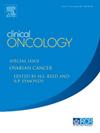The BRAFV600E Mutation Enhances Age-Based Prognostic Stratification in Radioiodine-Treated Papillary Thyroid Cancer: A Retrospective Cohort Study
IF 3
3区 医学
Q2 ONCOLOGY
引用次数: 0
Abstract
Aims
To evaluate whether BRAFV600E mutation status enhances the value of age in predicting clinical outcomes for papillary thyroid carcinoma (PTC) patients receiving radioactive iodide (RAI) therapy.
Materials and methods
We conducted a retrospective analysis of 1160 PTC patients treated with RAI therapy. Patients were stratified by age (≤18, 18-55, and ≥55 years) and BRAFV600E status. Clinicopathological characteristics, treatment responses, and risk factors for poor outcomes (biochemical/structural incomplete response biochemical incomplete response/structural incomplete response [BIR/SIR]) were analysed using logistic regression.
Results
BRAFV600E-positive patients aged ≤18 years showed aggressive features, including larger tumour size, higher lymph node metastasis rates, elevated thyroglobulin levels (TgAb-negative), and worse 6-month/3-year outcomes (all P < .05). Multivariate analysis confirmed high-risk subtypes, distant metastasis, and elevated Tg levels as independent BIR/SIR predictors. BRAFV600E-negative patients showed no significant age-related clinical characteristics and outcomes (P > .05).
Conclusion
BRAFV600E mutation status significantly modifies the impact of age in PTC patients with RAI therapy. Patients aged ≤18 years with BRAFV600E-positive exhibit distinct aggressive behaviours and poorer RAI therapy responses. These findings support integrating BRAFV600E testing with age stratification to refine risk assessment and therapeutic strategies.
BRAFV600E突变增强了放射性碘治疗的甲状腺乳头状癌基于年龄的预后分层:一项回顾性队列研究
目的评价BRAFV600E突变状态是否增强了年龄在预测接受放射性碘化物(RAI)治疗的甲状腺乳头状癌(PTC)患者临床预后中的价值。材料与方法我们对1160例接受RAI治疗的PTC患者进行回顾性分析。患者按年龄(≤18岁、18-55岁和≥55岁)和BRAFV600E状态进行分层。采用logistic回归分析临床病理特征、治疗反应和不良结局的危险因素(生化/结构不完全缓解生化不完全缓解/结构不完全缓解[BIR/SIR])。结果≤18岁brafv600e阳性患者表现为肿瘤体积较大、淋巴结转移率较高、甲状腺球蛋白水平升高(tgab阴性)、6个月/3年预后较差(P < 0.05)。多因素分析证实高危亚型、远处转移和Tg水平升高是独立的BIR/SIR预测因子。brafv600e阴性患者无明显的年龄相关临床特征和结局(P > 0.05)。结论brafv600e突变状态显著改变年龄对RAI治疗PTC患者的影响。年龄≤18岁的brafv600e阳性患者表现出明显的攻击行为和较差的RAI治疗反应。这些发现支持将BRAFV600E检测与年龄分层相结合,以完善风险评估和治疗策略。
本文章由计算机程序翻译,如有差异,请以英文原文为准。
求助全文
约1分钟内获得全文
求助全文
来源期刊

Clinical oncology
医学-肿瘤学
CiteScore
5.20
自引率
8.80%
发文量
332
审稿时长
40 days
期刊介绍:
Clinical Oncology is an International cancer journal covering all aspects of the clinical management of cancer patients, reflecting a multidisciplinary approach to therapy. Papers, editorials and reviews are published on all types of malignant disease embracing, pathology, diagnosis and treatment, including radiotherapy, chemotherapy, surgery, combined modality treatment and palliative care. Research and review papers covering epidemiology, radiobiology, radiation physics, tumour biology, and immunology are also published, together with letters to the editor, case reports and book reviews.
 求助内容:
求助内容: 应助结果提醒方式:
应助结果提醒方式:


